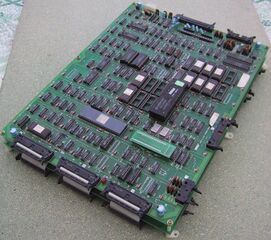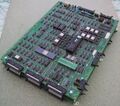Sega Hang-On hardware
From Sega Retro

| |||||
| Sega Hang-On hardware | |||||
|---|---|---|---|---|---|
| Manufacturer: Sega | |||||
|
Sega Hang-On hardware is an arcade system produced by Sega in 1985. It has no official name, but debuted with Hang-On (from which the name comes from) and went on to power several bike racing games of the mid-to-late 1980s. It is alternatively known as the Sega Space Harrier hardware, named after Space Harrier which released later in 1985.
The system specifications are similar to those of the later Sega System 16, but has a stronger focus on graphics, with a second 68000 processor and a separate video board with a powerful graphics chipset. Sega Hang-On hardware acts primarily as an advancement over the VCO Object board - it was designed to scale a large number of sprites/textures in real-time, allowing for the creation of three-dimensional graphics, with a player moving towards the screen. At the time of release, this technology was considered groundbreaking, the first in the Super Scaler series of arcade systems, and it would go on to fuel the Sega OutRun hardware specification as well as the X Board and Y Board systems.
As this board was designed to serve one purpose, only five games were produced to make use of this system, all of which opt for the third-person perspective.
Contents
Hardware
Designed by Sega AM2's Yu Suzuki, this was the first in Sega's Super Scaler series of three-dimensional arcade hardware. At the time of its release, this was the most powerful game system. The three-dimensional sprite/texture scaling was handled in a similar manner to textures in later texture-mapped polygonal 3D games of the 1990s. In an interview to 1UP.com Yu Suzuki said: [1]
| “ | My designs were always 3D from the beginning. All the calculations in the system were 3D, even from Hang-On. I calculated the position, scale, and zoom rate in 3D and converted it backwards to 2D. So I was always thinking in 3D.
|
„ |
— Yu Suzuki | ||
Hang-On was controlled using a video game arcade cabinet resembling a motorbike, which the player moved with their body. This began the "Taikan" trend, the use of motion-controlled arcade cabinets in many arcade games of the late 1980s, two decades before motion controls became popular on game consoles. [2]
Technical Specifications
Sega Hang-On
Sound
- Sound board: Sega 834‑5670 @ 16 MHz [2][3]
- Sound CPU: Zilog Z80 @ 4 MHz
- Performance: 8/16‑bit instructions, 8‑bit bus width, 0.58 MIPS
- Sound chips: 2 chips (19 channels)
- FM sound chip: Yamaha YM2203 @ 4 MHz (3 FM synthesis channels)
- PCM sound chip: SegaPCM (315‑5218) @ 4 MHz (stereo output, 16 PCM channels, 12‑bit audio, 31.25 kHz sampling rate) [2][4]
Graphics
- GPU: Sega Super Scaler 834‑5668 Video Board @ 25.174 MHz (16 processors, 140‑bit bus width, 84.545454 MB/s bandwidth) [5][6]
- 315‑5011 sprite line comparator: 16‑bit, 18.8811 MHz (12.5874 MHz sprite line buffer render clock, 6.2937 MHz sprite line buffer scan/erase) [7]
- 315‑5012 sprite generator control: 8‑bit, 25.174 MHz
- 6× 315‑5025 custom road graphics bit extraction devices: 24‑bit (3× 8‑bit), 5.882353 MHz,[8] 17.647059 MB/s ROM bandwidth
- 2× 315‑5049 tilemap generators: 32‑bit, 2× 8.333333 MHz; 16‑bit (8.333333 MHz),[9] 16‑bit (6.666667 MHz),[10] 30 MB/s RAM bandwidth
- 2× 315‑5107 (PAL16R6) horizontal timing control: 16‑bit (2× 8‑bit), 25 MHz [11]
- 315‑5108 (PAL16R6) vertical timing control: 8‑bit, 25 MHz [11]
- 315‑5122 (PAL16R4) timing processor: 8‑bit, 25 MHz [11]
- 2× CK2605 FPGA: 32‑bit (2× 16‑bit) [12][13]
- Video resolution: 320×224 (display), 400×262 (overscan) [2]
- Pixel clock: 6.2937 MHz
- Scanlines: 224 (display), 262 (overscan), progressive scan (non-interlaced)
- Refresh rate: 59.998141 Hz,[7] 60.054389 Hz [2]
- Frame rate: 59.998141 to 60.054389 frames per second
- Color depth: 32,768 (15‑bit RGB high color)
- Colors on screen: 6144
- Graphical planes: 5 layers
- 2 tilemap planes
- 1 text plane
- 1 sprite plane
- 1 road plane
- Sprite plane: Hardware sprite‑scaling, 128 sprites on screen per frame, 7680 sprites/textures scaled per second, dual line buffers, double buffering, sprite flipping [7]
- Sprite sizes: 8 to 256 pixels width, 8 to 256 pixels height [14]
- Colors per sprite: 16 colors (4‑bit)
- Line buffer resolution: 512 pixels (per scanline)
- Sprite fillrate: 12.5874 million pixels/texels per sec, 209,796 pixels/texels per frame
- Fillrate per scanline: 800 pixels/texels (800.75 ticks) per scanline, 100 sprites/textures per scanline
- Tilemap planes: 2 tilemap layers, row/column scrolling, 8×8 tiles/textures [2][15]
- Colors per tile: 16 colors (4‑bit), 12 colors (3‑bit)
- Tilemap resolution: 512×256 (1024×512 virtual resolution)
- Tilemap fillrate: 16.666666 million pixels/texels per sec (260,416 tiles/textures per sec), 277,786 pixels/texels per frame (4340 tiles per frame)
- Fillrate per scanline: 1060 pixels/texels per scanline, 132 tiles/textures per scanline
- Unique tiles on screen: 2048 tiles per frame (8 bytes per tile, 16 KB tile memory)
- Road plane: 512×256 resolution bitmap/texture
- Road fillrate: 8.823529 million (17.647059 MB/s) pixels/texels per sec, 147,063 pixels/texels per frame, 561 pixels/texels per scanline
- Fillrate: 38.077595 million pixels/texels per sec, 634,645 pixels/texels per frame, 2421 pixels/texels per scanline
Memory
Bandwidth
- RAM bandwidth: 128.545454 MB/s
- ROM bandwidth: 38.647059 MB/s
- Video Board: 17.647059 MB/s (24‑bit, 5.882353 MHz)
- ROM Board: 21 MB/s (29‑bit, 5.882353 MHz) [7][17]
Sega Space Harrier
The Sega Space Harrier hardware added the following upgrades in late 1985:
- Board composition: CPU Board, Video/Control Board, Sound Board, ROM Board [22]
- MCU: Intel i8751 @ 8 MHz (8‑bit instructions, 8 MIPS)
- CPU Board PAL: Sega 315‑5164, 315‑5165, 315‑5166, 315‑5167 [5]
- Sound chips: 2 chips (24 channels)
- FM sound chip: Yamaha YM2151 @ 4 MHz (8 FM synthesis channels)
- PCM sound chip: SegaPCM (315‑5218) @ 4 MHz (16 PCM channels)
Graphics
- GPU: Sega Super Scaler 171‑5320 Video Board @ 25.174 MHz (18 processors, 152‑bit bus width, 160 MB/s bandwidth) [22][5]
- 315‑5011 sprite line comparator: 16‑bit
- 315‑5012 sprite generator control: 8‑bit
- 6× 315‑5025 custom road graphics bit extraction devices: 24‑bit
- 2× 315‑5049 tilemap generators: 32‑bit
- 3× PAL16R6 (315‑5106, 315‑5107, 315‑5108) PAL: 24‑bit (3× 8‑bit)
- 3× CK2605 (315‑5168, 315‑5169, 315‑5171) FPGA: 48‑bit (3× 16‑bit)
- 2× PAL (315‑5170, 315‑5172)
- Color palette: 98,304
- 16‑bit color palette: 15‑bit RGB high color depth (32,768 colors) and 1‑bit shadow & highlight that triples up to 98,304 colors.
- Sprite plane: Translucent shadows
- Tilemap planes:
- Unique tiles on screen: 4096 tiles per frame (8 bytes per tile, 32 KB tile memory)
Memory
- Memory: Up to 2.7 MB (992 KB main, 1578 KB video, 194.25 KB sound)
- RAM: 308.25 KB,[2] including 208 KB high‑speed SRAM [23]
- Main RAM: 64 KB (16 KB work RAM, 48 KB sub‑RAM), including 16 KB SRAM
- Video RAM: 242 KB, including 192 KB SRAM
- CPU Board: 50 KB (32 KB tiles, 4 KB text, 2 KB sprites, 4 KB colors, 8 KB roads)
- Video Board: 192 KB SRAM
- Sound RAM: 2.25 KB
- ROM: Up to 2456 KB EPROM (928 KB main, 1336 KB video, 80 KB sound)
Bandwidth
Gallery
List of Games
- Hang-On (1985)
- Space Harrier (1985)
- Enduro Racer (1986)
- Super Hang-On (1987)
- Limited Edition Hang-On (1991)
References
- ↑ File:HangOn Arcade JP Manual.pdf, page 38
- ↑ 2.0 2.1 2.2 2.3 2.4 2.5 2.6 2.7 https://github.com/mamedev/mame/blob/master/src/mame/drivers/segahang.cpp
- ↑ File:HangOn Schematics.pdf, page 13
- ↑ https://github.com/mamedev/mame/blob/master/src/mame/drivers/segaorun.cpp
- ↑ 5.0 5.1 5.2 http://imame4all.googlecode.com/svn-history/r146/Reloaded/trunk/src/mame/video/segaic16.c
- ↑ 6.0 6.1 6.2 File:HangOn Schematics.pdf
- ↑ 7.0 7.1 7.2 7.3 7.4 http://cgfm2.emuviews.com/txt/p16tech.txt
- ↑ File:M27256 datasheet.pdf
- ↑ 9.0 9.1 File:DS2064 datasheet.pdf
- ↑ 10.0 10.1 File:DS2016 datasheet.pdf
- ↑ 11.0 11.1 11.2 File:PAL16R datasheet.pdf
- ↑ File:303A-011A Device List.pdf, page 11
- ↑ File:CK2605 Fusemap.pdf
- ↑ https://github.com/mamedev/mame/tree/master/src/mame/drivers/segas16a.cpp
- ↑ http://cgfm2.emuviews.com/txt/s16tech.txt
- ↑ http://www.alldatasheet.com/datasheet-pdf/pdf/212366/CYPRESS/CY62148-55SC.html
- ↑ 17.0 17.1 17.2 http://hardware.speccy.org/datasheet/27c256.pdf
- ↑ 18.0 18.1 http://eeshop.unl.edu/pdf/27128.pdf
- ↑ File:MBM2764 datasheet.pdf
- ↑ http://mamedb.com/game/hangon
- ↑ File:HangOn Schematics.pdf, page 5
- ↑ 22.0 22.1 22.2 File:SpaceHarrier Schematics.pdf
- ↑ http://flyers.arcade-museum.com/flyers_video/sega/16208102.jpg
- ↑ http://www.mamedb.com/game/shangon
- ↑ http://flyers.arcade-museum.com/flyers_video/sega/16184702.jpg
- ↑ http://flyers.arcade-museum.com/flyers_video/sega/16003602.jpg
- ↑ File:SpaceHarrier Schematics.pdf, page 10
- ↑ http://www.alldatasheet.com/datasheet-pdf/pdf/47127/SONY/CXK581000AM.html
| Sega arcade boards |
|---|
| Originating in arcades |
|
77
78
79
80
81
82
83
84
85
86
87
88
89
90
91
92
93
94
95
96
97
98
99
|
| Console-based hardware |
|
84
85
86
87
88
89
90
91
92
93
94
95
96
97
98
99
00
01
02
03
04
05
06
07
08
09
10
11
12
13
14
|
| PC-based hardware |
|
05
06
07
08
09
10
11
12
13
14
15
16
17
18
19
20
21
22
23
|

